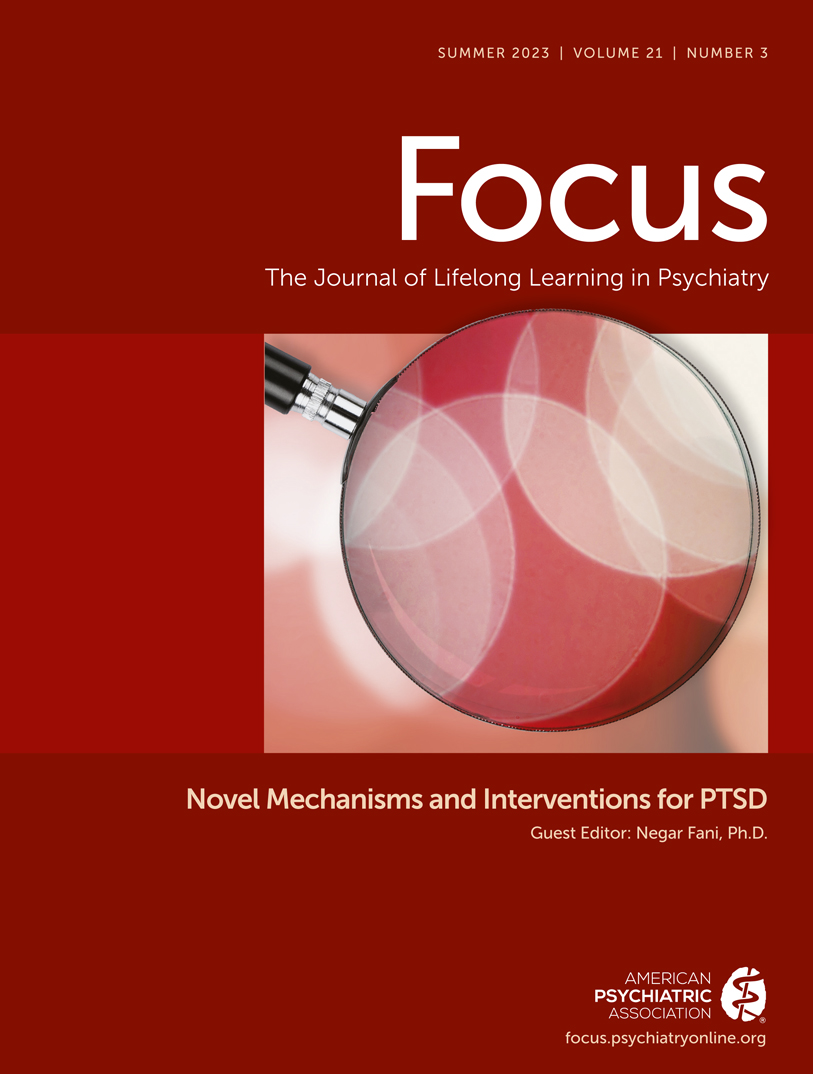Novel Mechanisms and Interventions for PTSD
This section contains a compilation of recent publications that have shaped the thinking in the field as well as classic works that remain important to the subject reviewed in this issue. This bibliography has been compiled by experts in the field. Articles from the bibliography that are reprinted in this issue are in bold type.
: The neurobiology and pharmacotherapy of posttraumatic stress disorder. Annu Rev Pharmacol Toxicol 2019; 59:171–189Crossref, Google Scholar
: Dose-related effects of ketamine for antidepressant-resistant symptoms of posttraumatic stress disorder in veterans and active duty military: a double-blind, randomized, placebo-controlled multi-center clinical trial. Neuropsychopharmacology 2022; 47:1574–1581Crossref, Google Scholar
: Acute stress disorder as a predictor of posttraumatic stress disorder: a systematic review. J Clin Psychiatry 2011; 72:233–239Crossref, Google Scholar
: The lingering impact of resolved PTSD on subsequent functioning. Clin Psychol Sci 2016; 4:493–498Crossref, Google Scholar
: Screening and treating hospitalized trauma survivors for posttraumatic stress disorder and depression. J Trauma Acute Care Surg 2019; 87:440–450Crossref, Google Scholar
: A randomized controlled trial of repeated ketamine administration for chronic posttraumatic stress disorder. Am J Psychiatry 2021; 178:193–202Crossref, Google Scholar
: Breakthrough for trauma treatment: safety and efficacy of MDMA-assisted psychotherapy compared to paroxetine and sertraline. Front Psychiatry 2019; 10:650–659Crossref, Google Scholar
: Psychological and Pharmacological Treatments for Adults with Posttraumatic Stress Disorder: A Systematic Review Update. Rockville, MD, Agency for Healthcare Research and Quality, 2022Google Scholar
: The origin of MDMA (ecstasy) revisited: the true story reconstructed from the original documents. Addiction 2006; 101:1241–1245Crossref, Google Scholar
: Interoceptive cardiac signals selectively enhance fear memories. J Exp Psychol Gen 2021; 150:1165–1176Crossref, Google Scholar
: The pharmacology and clinical pharmacology of 3,4-methylenedioxymethamphetamine (MDMA, “ecstasy”). Pharmacol Rev 2003; 55:463–508Crossref, Google Scholar
: Psychobiologic effects of 3,4-methylenedioxymethamphetamine in humans: methodological considerations and preliminary observations. Behav Brain Res 1996; 73:103–107Crossref, Google Scholar
: How the neurocircuitry and genetics of fear inhibition may inform our understanding of PTSD. Am J Psychiatry 2010; 167:648–662Crossref, Google Scholar
: The brain-body disconnect: a somatic sensory basis for trauma-related disorders. Front Neurosci 2022; 16:1015749Crossref, Google Scholar
: Interoception and mental health: a roadmap. Biol Psychiatry Cogn Neurosci Neuroimaging 2018; 3:501–513Crossref, Google Scholar
: National estimates of exposure to traumatic events and PTSD prevalence using DSM-IV and DSM-5 criteria. J Trauma Stress 2013; 26:537–547Crossref, Google Scholar
: Reviewing the potential of psychedelics for the treatment of PTSD. Int J Neuropsychopharmacol 2020; 23:385–400Crossref, Google Scholar
: Multifaceted empathy of healthy volunteers after single doses of MDMA: a pooled sample of placebo-controlled studies. J Psychopharmacol 2017; 31:589–598Crossref, Google Scholar
: Critical period plasticity as a framework for psychedelic-assisted psychotherapy. Front Neurosci 2021; 15:710004Crossref, Google Scholar
: Deconstructing the gestalt: mechanisms of fear, threat, and trauma memory encoding. Neuron 2019; 102:60–74Crossref, Google Scholar
: The contextual brain: implications for fear conditioning, extinction and psychopathology. Nat Rev Neurosci 2013; 14:417–428Crossref, Google Scholar
: The cost-effectiveness of MDMA-assisted psychotherapy for the treatment of chronic, treatment-resistant PTSD. PLoS One 2020; 15:e0239997Crossref, Google Scholar
: Post-traumatic stress disorder. Med Clin North Am 2023; 107:85–99Crossref, Google Scholar
: MDMA-assisted therapy for severe PTSD: a randomized, double-blind, placebo-controlled phase 3 study. Nat Med 2021; 27:1025–1033Crossref, Google Scholar
: MDMA-assisted psychotherapy for treatment of PTSD: study design and rationale for phase 3 trials based on pooled analysis of six phase 2 randomized controlled trials. Psychopharmacology (Berl) 2019; 236:2735–2745Crossref, Google Scholar
: The safety and efficacy of {+/-}3,4-methylenedioxymethamphetamine-assisted psychotherapy in subjects with chronic, treatment-resistant posttraumatic stress disorder: the first randomized controlled pilot study. J Psychopharmacol 2011; 25:439–452Crossref, Google Scholar
: Neuroimaging correlates and predictors of response to repeated-dose intravenous ketamine in PTSD: preliminary evidence. Neuropsychopharmacology 2021; 46:2266–2277Crossref, Google Scholar
: 3,4-methylenedioxymethamphetamine-assisted psychotherapy for treatment of chronic posttraumatic stress disorder: a randomized phase 2 controlled trial. J Psychopharmacol 2018; 32:1295–1307Crossref, Google Scholar
: mHealth solutions for early interventions after trauma: improvements and considerations for assessment and intervention throughout the acute post-trauma period. MHealth 2018; 4:22Crossref, Google Scholar
: Methylenedioxymethamphetamine (MDMA) in psychiatry: pros, cons, and suggestions. J Clin Psychopharmacol 2018; 38:632–638Crossref, Google Scholar
: Current perspective on MDMA-assisted psychotherapy for posttraumatic stress disorder. J Contemp Psychother 2018; 48:99–108Crossref, Google Scholar
: Therapeutic effect of increased openness: investigating mechanism of action in MDMA-assisted psychotherapy. J Psychopharmacol 2017; 31:967–974Crossref, Google Scholar



